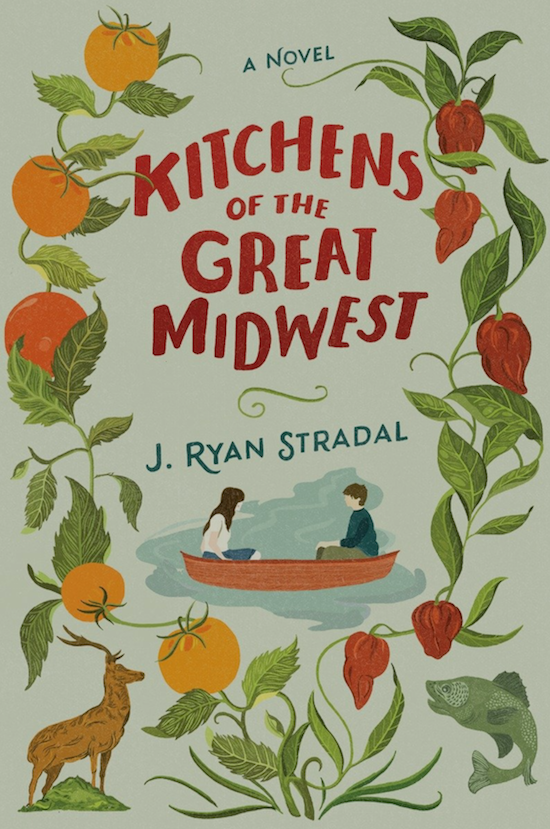
The Kitchens of the Great Midwest by J. Ryan Stradal is the best book I’ve read so far this year. Food is both its frame and its unifying thread and yes, there are recipes. Yet, it’s only sort of about food. Either way, it takes guts to start a story with lutefisk.
Eva Thorvald, our protagonist, is born to a would-be sommelier and a lutefisk-making chef father who meticulously plans her first foods and takes her to the farmers market. Both leave Eva in relatively short order. The book chronicles Eva’s journey from a pre-teen who grows Scoville scarring hot chiles and uses them to exact revenge on her tormenters, to cooking wunderkind who has a relationship with an older man who fancies himself a bon vivant, to food entrepreneur and pop-up chef. It’s a series of seemingly everyday moments that are actually formative for Eva.
Wound around and woven into Eva’s story is an amazing cast of characters so rich, even the ones who appear only briefly, leave a mark on both the reader and on Eva.
There’s Will Prager, the first boy who falls for her, but stiffs the waitress on a tip on their first date; Octavia Kincade, a snipey, jealous would-be rival for the bon vivant’s affections, who thinks she’s big-hearted and selfless and ends up getting exactly what she deserves.
And there’s Pat Prager. Oh, Pat, what can you say about Pat? She steals the show in the Bars chapter, as a five-time winner of the county bakeoff. She’s a provincial busy body holding tight to her Midwestern values, silently cutting down newcomer Celeste, but regretting it, as she’s a woman of God. Be welcoming and treat others as you’d like to be treated, and all that. But in Stradal’s hands, she’s no caricature of a Midwestern church lady.
Pat goes on to take her bars to Petite Noisette’s Best of Bake, a contest sponsored by a culinary lifestyle Web site based in the Twin Cities – the “Cities.” As Pat describes the site, “[I]t seemed a little weird. Nothing she’d much care to read regularly. They reviewed restaurants and boutique hotels and seemed intensely concerned about where stuff like the cotton in the hotel towels came from or the chives on a baked potato were grown. They sourced every ingredient of every meal they reviewed and put them all on little maps. Pat assumed they weren’t very trusting people.”
The Best of Bake is the worst-worst-worst of hipster foodie contests. It’s a Portlandia sketch gone to Minneapolis-St. Paul. At first they assume her son is the entrant, she gets the Mean Girls treatment from the registration desk staff for not knowing her ingredient sources, and then in a run-in with two other entrants, one of them debates throwing up a taste of Pat’s peanut butter bars over whether or not the butter in them has hormones.
It’s a fairly gentle skewering of food culture in the US right now. We all want to have the ability to make informed choices about what we eat. And yet, there are too many instances where people equate and confuse preference with actual physical responses and medical conditions. “She suddenly felt sorry for these people, for perverting the food of their childhood, the food of their mothers and grandmothers and rejecting its unconditional love in favor of what? What? Pat did not understand.”
Some will assert that the butter of our mothers and grandmothers generations came from grass-fed cows rather than industrial farms. Sometimes, maybe. In some places. And for the rest, the ability to get that information, let alone the butter, is a first world privilege of the highest order.
Of course, Pat and Eva’s paths cross at the Best of Bake. Eva is one of the judges and she comments that she hasn’t had bars like Pat’s since she was a kid in Iowa.
I loved everything about this book. There are some gorgeous food passages, some nostalgia for heirloom varieties of corn and tomatoes, and for the art of making real Caesar salad – with fresh ingredients in the right proportions just before enjoying it.
“Eva rubbed the sides of the wooden bowl with the bisected cloves of Porcelain garlic and prepared the dressing, a mixture of Koroneiki olive oil, warm coddled free-range brown egg yolks, Worcestershire sauce, freshly ground Madagascar black peppercorns, one freshly diced Porcelain clove and a bit of Meyer lemon juice. She placed single whole romaine leaves on everyone’s plates and drizzled the dressing over them, topping each with four homemade sourdough bread croutons.”
Direct, descriptive and simple, perhaps deceptively so. The Kitchens of the Great Midwest is presented to you as a plate of spaghetti with red sauce. The noodles are not tangled, but interconnected strands and the sauce isn’t from a jar. Its tomatoes, crushed and sautéed with garlic, are both sweet and acidic. And at the end of it all, you’ll be wanting to soak up every last bit of the sauce with a slice of rustic bread.
The only thing missing from The Kitchens of the Great Midwest is everyone stopping to take photos of each plate as it’s put on the table. But when you stop to think about it, maybe in some sense that’s what Stradal has given us, the word pictures in a continuous feed of ‘grams’ that Eva lived. I’m giving them all a ‘like.’




